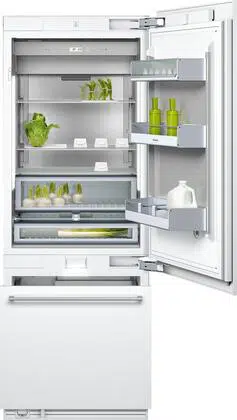Loading ...
Loading ...
Loading ...

15
Freezer compartment
9
WARNING:
Do not store explosive substances in the appliance.
Risk of explosion!
9 CAUTION:
Do not refreeze thawing or thawed food. Before
freezing the food, first boil or fry it. Never keep frozen
food longer than the maximum storage duration.
Use the freezer compartment
▯ To store frozen food.
▯ To make ice cubes.
▯ To freeze food.
Note:
Ensure that the freezer compartment door has always
been closed properly! If the door is open, the frozen
food will thaw. The freezer compartment will become
covered in thick ice. Besides: energy is wasted due to
the high power consumption!
Freezing and storing food
Purchasing frozen food
▯ The packaging must not be damaged.
▯ Pay attention to the expiration date.
▯ Temperature in the supermarket freezer must be
0 °F (–18 °C) or lower.
▯ If possible, transport frozen food in an insulated
bag and place quickly in the freezer compartment.
Freezing fresh food
Freeze only fresh and undamaged food.
To retain the best possible nutritional value, flavor and
color, vegetables should be blanched before freezing.
Eggplants, peppers, zucchini and asparagus do not
require blanching.
Literature on freezing and blanching can be found in
bookstores.
Note:
Keep food which is to be frozen away from food which
is already frozen.
▯ The following foods are suitable for freezing:
Baked goods, fish and seafood, meat, game,
poultry, vegetables, fruit, herbs, eggs without
shells, dairy products such as cheese and butter,
ready meals and leftovers such as soups, stews,
cooked meat and fish, potato dishes, soufflés and
desserts.
▯ The following foods are not suitable for freezing:
Vegetables that are usually consumed raw, such
as lettuce or radishes, eggs in shells, grapes,
whole apples, pears and peaches, hard-boiled
eggs, yoghurt, soured milk, sour cream, crème
fraîche and mayonnaise.
Packing frozen food
To prevent food from losing its flavor or drying out,
place in airtight containers.
1. Place food in packaging.
2. Remove air.
3. Seal the packaging.
4. Label packaging with contents and date of
freezing.
Suitable packaging:
Cling wrap, tubular film made of polyethylene,
aluminum foil, freezer containers.
These products are available from specialist outlets.
Unsuitable packaging:
Wrapping paper, greaseproof paper, cellophane, bin
liners and used shopping bags.
Items suitable for sealing packaged food:
Rubber bands, plastic clips, string, cold-resistant
adhesive tape, etc.
Bags and tubular film made of polyethylene (PE) can
be sealed with a film heat sealer.
Shelf life of frozen food
Shelf life depends on the type of food.
At a temperature of 0° F (–18° C):
▯ Fish, sausage, ready meals, cakes and pastries:
up to 6 months
▯ Cheese, poultry and meat:
up to 8 months
▯ Vegetables, fruit:
up to 12 months
Loading ...
Loading ...
Loading ...
